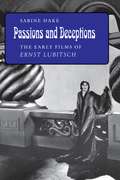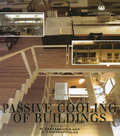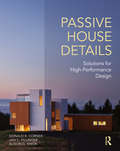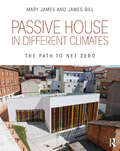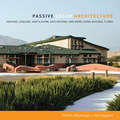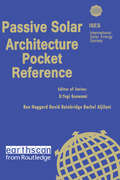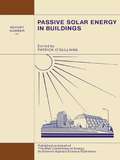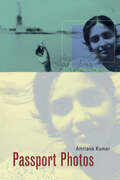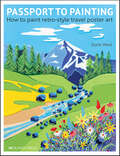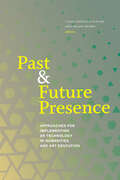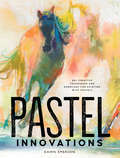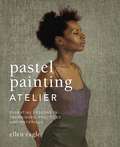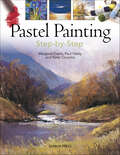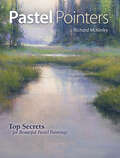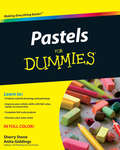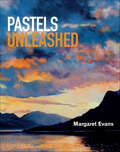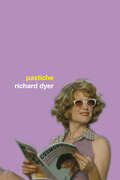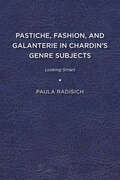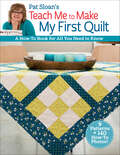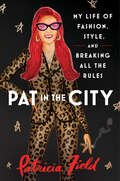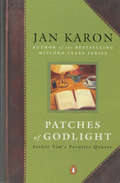- Table View
- List View
Passions and Deceptions: The Early Films of Ernst Lubitsch
by Sabine HakeA collaborator with Warner Brothers and Paramount in the early days of sound film, the German film director Ernst Lubitsch (1892-1947) is famous for his sense of ironic detachment and for the eroticism he infused into such comedies as So This Is Paris and Trouble in Paradise. In a general introduction to his silent and early sound films (1914-1932) and in close readings of his comedies, Sabine Hake focuses on the visual strategies Lubitsch used to convey irony and analyzes his contribution to the rise of classical narrative cinema. Exploring Lubitsch's depiction of femininity and the influence of his early German films on his entire career, she argues that his comedies represent an important outlet for dealing with sexual and cultural differences. The readings cover The Oyster Princess, The Doll, The Mountain Cat, Passion, Deception, So This Is Paris, Monte Carlo, and Trouble in Paradise, which are interpreted as part of an underlying process of negotiation between different modes of representation, narration, and spectatorship--a process that comprises the conditions of production in two different national cinemas and the ongoing changes in film technology. Drawing attention to Lubitsch's previously neglected German films, this book presents the years until 1922 as the formative period in his career.
Passive Cooling of Buildings: Passive Cooling Of Buildings (BEST (Buildings Energy and Solar Technology))
by D. AsimakopoulosEnergy use in buildings in the EU represents about 40% of the total annual energy consumption. With greater awareness of the need to reduce energy consumption comes a growth of interest in passive cooling, particularly as an alternative to air-conditioning. This book describes the fundamentals of passive cooling together with the principles and formulae necessary for its successful implementation. The material is comprised largely of information and results compiled under the SAVE European Research Programme.
Passive House Details: Solutions for High-Performance Design
by Alison G. Kwok Donald B. Corner Jan C. FillingerPassive House Details introduces the concepts, principles, and design processes of building ultralow-energy buildings. The objective of this book is to provide design goals, research, analysis, systems, details, and inspiring images of some of the most energy-efficient, carbon-neutral, healthy, and satisfying buildings currently built in the region. Other topics included: heat transfer, moisture management, performance targets, and climatic zones. Illustrated with more than 375 color images, the book is a visual catalog of construction details, materials, and systems drawn from projects contributed from forty firms. Fourteen in-depth case studies demonstrate the most energy-efficient systems for foundations, walls, floors, roofs, windows, doors, and more.
Passive House in Different Climates: The Path to Net Zero
by Mary James James BillPassive House in Different Climates introduces the seven Passive House principles, to help you create super-insulated, airtight buildings that require minimal energy use to heat, cool, dehumidify, and ventilate, with superior indoor air quality and year-round comfort. Seventeen case studies in four climate zones---marine, cold and very cold, mixed-dry and hot-dry, and mixed-humid and hot-humid---and in ten countries, show you how to achieve net-zero energy regardless of where you’re building or what type of building is required. Includes more than 150 color illustrations.
Passive Methods as a Solution for Improving Indoor Environments
by José A. Orosa Armando C. OliveiraThere are many aspects to consider when evaluating or improving an indoor environment; thermal comfort, energy saving, preservation of materials, hygiene and health are all key aspects which can be improved by passive methods of environmental control. Passive Methods as a Solution for Improving Indoor Environments endeavours to fill the lack of analysis in this area by using over ten years of research to illustrate the effects of methods such as thermal inertia and permeable coverings; for example, the use of permeable coverings is a well known passive method, but its effects and ways to improve indoor environments have been rarely analyzed. Passive Methods as a Solution for Improving Indoor Environments includes both software simulations and laboratory and field studies. Through these, the main parameters that characterize the behavior of internal coverings are defined. Furthermore, a new procedure is explained in depth which can be used to identify the real expected effects of permeable coverings such as energy conservation and local thermal comfort as well as their working periods in controlling indoor environments. This theoretical base is built on by considering future research work including patents and construction indications which will improve indoor environmental conditions with evidence from real data. This makes Passive Methods as a Solution for Improving Indoor Environments an ideal resource for specialists and researchers focusing on indoor air quality, thermal comfort, and energy saving or with a general interest in controlling indoor environments with passive methods.
Passive Solar Architecture
by David A. Bainbridge Ken HaggardThis pocket reference book provides a wealth of practical information at your fingertips, whenever you need it. Rich in background detail, at-a-glance tables and diagrams, equations, and more, the Passive Solar Architecture Pocket Referenceis a handy resource for architects, engineers and students. Coverage includes: Definitions Load determinants and Responses (including world wide biomes and climates, building metabolism and response, thermal sources and sinks, passive building responses to sources and sinks, tuning the building to the environment, optimizing insulation & thermal mass for comfort) Contextual Aspects (including microclimate and siting, temperatures, humidity, wind, radiation and comfort parameters) Passive Components (including building envelope, passive solar terminology, orientation, apertures and glazing, thermal storage, thermal control and materials Design Tools (including sun path diagrams, sun peg diagrams, air flow relationships, thermal modelling and life cycle design) Specific Functions (including passive heating, passive cooling and ventilation, natural lighting, passive water heating, resource collection and Integrated design)
Passive Solar Architecture Pocket Reference (Energy Pocket Reference)
by David A. Bainbridge Ken Haggard Rachel AljilaniOur pocket reference books provide a wealth of practical information at your fingertips, whenever you need it. Rich in background detail, at-a-glance tables and diagrams, equations, and more, the Passive Solar Architecture Pocket Reference is a handy resource for architects, engineers and students. Coverage includes: definitions load determinants and Responses (including world wide biomes and climates, building metabolism and response, thermal sources and sinks, passive building responses to sources and sinks, tuning the building to the environment, optimizing insulation & thermal mass for comfort) contextual aspects (including microclimate and siting, temperatures, humidity, wind, radiation and comfort parameters passive components (including building envelope, passive solar terminology, orientation, apertures and glazing, thermal storage, thermal control and materials design tools (including sun path diagrams, sun peg diagrams, air flow relationships, thermal modelling and life cycle design specific functions (including passive heating, passive cooling and ventilation, natural lighting, passive water heating, resource collection and integrated design).
Passive Solar Energy in Buildings: Watt Committee: report number 17
by Patrick O´SullivanThis report indicates that the benefits that accrue to a building and its occupants from a consideration of solar radiation are greatest when the 'passive solar component' is seen in perspective, as a natural part of an integrated approach to climatically interactive low-energy building design.
Passport Photos
by Amitava KumarPassport Photos, a self-conscious act of artistic and intellectual forgery, is a report on the immigrant condition. A multigenre book combining theory, poetry, cultural criticism, and photography, it explores the complexities of the immigration experience, intervening in the impersonal language of the state. Passport Photos joins books by writers like Edward Said and Trinh T. Minh-ha in the search for a new poetics and politics of diaspora. Organized as a passport, Passport Photos is a unique work, taking as its object of analysis and engagement the lived experience of post-coloniality--especially in the United States and India. The book is a collage, moving back and forth between places, historical moments, voices, and levels of analysis. Seeking to link cultural, political, and aesthetic critiques, it weaves together issues as diverse as Indian fiction written in English, signs put up by the border patrol at the U.S.-Tijuana border, ethnic restaurants in New York City, the history of Indian indenture in Trinidad, Native Americans at the Superbowl, and much more. The borders this book crosses again and again are those where critical theory meets popular journalism, and where political poetry encounters the work of documentary photography. The argument for such border crossings lies in the reality of people's lives. This thought-provoking book explores that reality, as it brings postcolonial theory to a personal level and investigates global influences on local lives of immigrants.
Passport to Painting: How to Paint Retro-Style Travel Poster Art
by Susie WestStylish retro travel posters bring to mind summer holidays, happiness and fun. Perennially popular as wall art, their strong designs and clean, flat colours are perfect for hobby artists to emulate.A complete guide to producing your own travel-poster art, this book includes guidance on composing a strong design, selecting colours to make sure your artwork pops, and adding lettering for a picture-perfect finished poster.Learn to create key poster elements such as clouds, skies, water and architecture, and discover how to add your own stylized lettering. There are six striking international projects to complete, or you can use your newfound skills to celebrate your own home town or treasured place. This book is packed with examples of Susie West’s inspiring artwork and a short history of travel posters.Since 2015, Susie West has been working her way around the UK recreating the upbeat, retro charm of travel posters in the modern world. This book shares her techniques and secrets for producing fun, charming artwork. Suitable for beginners, this is a great way into art for those who want to develop their skills, or for experienced artists wanting to try something new.
Past and Future Presence: Approaches for Implementing XR Technology in Humanities and Art Education
by Brian Beams Lissa Crofton-SleighWhile uses and studies of XR technology within STEM-based education have been plentiful in recent years, there has been lesser or even, at times, a lack of coverage for this novel learning tool in the arts and humanities.Past and Future Presence aims to bridge some of that gap by presenting research-based theory and case studies of successful application and implementation of XR technology into postsecondary educational settings, ranging in topics from ancient to modern languages, classical and contemporary art, and reenvisioned historical scenes and events presented in ways never seen before. The studies also contemplate how this novel medium can enhance and supplement learning in classrooms and other formal or informal learning environments. The volume as a whole is intended to demonstrate to educators, scholars, and researchers in higher education the potential value of integrating XR technology into their classrooms and to provide a strong argument for college and university administrators to invest in training and development of new research and content for classrooms inside and outside of STEM. The authors of these chapters come from a diverse range of backgrounds at different stages of their careers, providing a broad crosssection of scholastic work within the humanities and arts. Each chapter offers a different angle or approach to incorporating XR technology into teaching or research within different subject areas. As the volume suggests, this technology also places additional emphasis on the humanity within the humanities, by focusing on increasing connection between users and different cultures, time periods, and perspectives.
Pastel Innovations: 60+ Creative Techniques and Exercises for Painting with Pastels
by Dawn EmersonPastel Painting Techniques That Are Revolutionary, Fun and Easy! Designed for beginners considering using pastel for the first time, for experienced artists who may feel uninspired, and for anyone in between, the skills you will gain with Pastel Innovations, will help you build confidence and open your world so you can paint what CAN BE, not just what you THINK is. Explore the unique joys of pastel painting with:An exploration of the basics: You'll expand your artist's vocabulary learning to use the elements and fundamentals of design to create beautiful, balanced paintings.20 simple exercises build off each other and help you grow as an artist, little by little, building confidence.40+ innovative pastel painting techniques: Feel inspired as you learn new approaches to using pastel to build up and reveal layers, incorporate monotypes as underpaintings, create texture that cannot be duplicated by drawing or painting, and more.Thoughtful self critique: Questions, approaches and checklists that will result in better art, while at the same time making you a better artist.Leave your expectations behind and engage in the process of pastel painting with a newfound freedom to play and explore!
Pastel Painting Atelier: Essential Lessons in Techniques, Practices, and Materials
by Ellen EagleRevel in the luminous and vibrant qualities of pastel with Ellen Eagle's essential course in the history, techniques, and practices of the medium. In this comprehensive yet intimate guide, Eagle explores pastel's rich but relatively unexamined past, reveals her own personal influences and approaches, and guides you toward the discovery and mastery of your own vision. In Pastel Painting Atelier, you will find: * Advice on basic materials: guidance on building, storing, and organizing a collection of pastels; choosing the right paper; and the importance of experimentation * Studio practice suggestions: ideas for creating your ideal working environment and recipes for making your own pastels and supports * Study of the working process: lessons on proportion, gesture, composition, color, application, identifying and correcting problems, and recognizing when a work is finished * Meditation on subject: cues for extrapolating the subtle details, presence, and temporal features of whatever you choose to paint * Step-by-step demonstrations: Eagle's acute insights into her own works as they progress A magnificent selection of works by masters such as James Abbott McNeill Whistler, Rosalba Carriera, Mary Cassatt, and Eugene Delacroix augment this guide, as do works by contemporary artists including Harvey Dinnerstein, Elizabeth Mowry, and Daniel Massad. Aimed at serious artists, this guide enlightens, instructs, and inspires readers to create brilliant and sensitive works in the historic medium of pastel.
Pastel Painting Step-by-Step
by Margaret Evans• 13 demonstrations • Over 250 step by step photographs • An excellent reference book for beginners and experienced artists
Pastel Pointers: Top 100 Secrets for Beautiful Paintings
by Richard MckinleyTop Secrets for Beautiful Pastel Paintings Richard McKinley has been a professional artist for over 35 years. Factor in nearly as many years of teaching experience, and that adds up to a whole lot of know-how to share. In Pastel Pointers, he lays it all out: information on tools, materials, color, composition, landscape elements, finishes and more. Compiles the best of McKinley's popular Pastel Pointers blog and Pastel Journal columns Covers frequently asked questions ("How do I achieve natural-looking greens?") and simple solutions to common problems, such as excess pigment buildup Includes a chapter on "The Business of Pastels"—tips for framing, shipping, preparing for gallery shows, and otherwise representing your work in a professional manner This book covers everything from the fundamentals to get you going (how to lay out your palette, create an underpainting, evoke luminous effects) to inspirations that will keep you growing (plein air painting, working in a series, keeping a painting journal). Whether you're a beginner or an experienced painter anxious to explore the expressive possibilities of pastel, this is your guide to making the most of the medium.
Pastel Step By Step
by Marla BaggettaIf you like working with color, then you'll love pastels! Pastel has recently experienced a renewed popularity as a serious painting medium, and several manufacturers now make high-quality materials readily available to artists. Pastels are easy to use, and you don't have to worry about drying times, toxicity, or odors--as you might if you were working with paint. And pastel is also attractive to many artists because of its versatility--it is both a painting and a drawing medium. Moreover, you can create a seemingly endless variety of textures and effects with the vast number of hues that are available. And pastel is an extremely fluid and forgiving medium, which makes it great for beginners. In this book, the author demonstrates a variety of techniques and show you how to render an array of subject matter. As you learn more about the vibrant and fascinating world of pastel, you'll begin to recognize the endless possibilities that this medium has to offer!
Pastels For Dummies
by Sherry Stone Clifton Anita Marie GiddingsThe latest tips and techniques for working with pastels - in full colorPastels offer bright colors, a great level of portability, and no drying time - plus they're relatively inexpensive and can be used to draw and paint on almost any surface. Pastels For Dummies covers the many aspects of this exciting medium, from the fundamentals of choosing the right materials to step-by-step projects, including landscapes, abstracts, and portraits. Inside you'll find hands-on, easy-to-follow exercises and attractive full-color artwork.Presents drawing, painting, and shading techniques and styles in an easy-to-understand formatAccessible to artists of all levelsDiscover your inner artist with Pastels For Dummies and make your artwork come alive!
Pastels Unleashed
by Margaret Evans• High-profile author • Fantastic innovative techniques to inspire pastel artists • Packed with excellent tuition and inspiring paintings • 6 beautiful step-by-step projects
Pastels for the Absolute Beginner (Absolute Beginner Craft)
by Rebecca de MendonçaDiscover the limitless possibilities of pastels with this beginner’s guide to creating modern, lively, and colorful pastel artwork.Artist and teacher Rebecca de Mendoça offers beginners a complete course in using pastels. Step-by-step exercises and longer projects help you to build the essential skills you need to paint a range of subjects, including landscapes, still life, portraits, and animals. Vital drawing techniques are explained and demonstrated, along with easy-to-follow explanations of color theory, composition, and the pastels themselves.This volume includes techniques for using both hard and soft pastels, eight skill-building projects, and a wealth of finished artwork to provide ideas and inspiration.
Pastiche
by Richard DyerWriting with his customary wit and style, Richard Dyer argues that while pastiche can be used to describe works which contain montage or collage, it can also be used to describe works which are a kind of imitation of previous works. Investigating a wide range of cultural texts drawn from films, videos, novels, poetry, rap tracks, music and painting, Richard Dyer explores issues of text, genre, and the use of pastiche as a resource within a work. The final chapter draws together the underlying concern of the book with affect and poetics and discusses the politics of pastiche.
Pastiche, Fashion, and Galanterie in Chardin’s Genre Subjects: Looking Smart (Studies in Seventeenth- and Eighteenth-Century Art and Culture)
by Paula RadisichPastiche, Fashion and Galanterie in Chardin’s Genre Subjects seeks to understand how Chardin’s genre subjects were composed and constructed to communicate certain things to the elites of Paris in the 1730s and 1740s. The book argues against the conventional view of Chardin as the transparent imitator of bourgeois life and values so ingrained in art history since the nineteenth century. Instead, it makes the case that these pictures were crafted to demonstrate the artist’s wit (esprit) and taste, traits linked to conventions of seventeenth-century galanterie. Early eighteenth-century Moderns like Jean-Siméon Chardin (1699–1779) embraced an aesthetic grounded upon a notion of beauty that could not be put into words—the je ne sais quoi. Despite its vagueness, this model of beauty was drawn from the present, departed from standards of formal beauty, and could only be known through the critical exercise of taste. Though selecting subjects from the present appears to be a simple matter, it was complicated by the fact that the modernizers expressed themselves through the vehicles of older, established forms. In Chardin’s case, he usually adapted the forms of seventeenth-century Dutch and Flemish genre painting in his genre subjects. This gambit required an audience familiar enough with the conventions of Lowlands art to grasp the play involved in a knowing imitation, or pastiche. Chardin’s first group of enthusiasts accordingly were collectors who bought works of living French artists as well as Dutch and Flemish masters from the previous century, notably aristocratic connoisseurs like the chevalier Antoine de la Roque and Count Carl-Gustaf Tessin. Published by University of Delaware Press. Distributed worldwide by Rutgers University Press.
Pat Sloan's Tantalizing Table Toppers: A Dozen Eye-Catching Quilts to Perk Up Your Home
by Pat SloanSet Your Table in Style Table runners and small table toppers are perennial favorites among quilters. They're easy on the budget and easy on your schedule. But best of all, they let you show off your love of quilting to family and friends, whether you're setting the table for a casual coffee break with neighbors, wine and cheese with your book club, or full-on holiday festivities. You’ll find a dozen patterns in this book as well as one of Pat Sloan’s favorite dessert recipes. Make one or make them all, and you’ll be proudly showing off the results in no time. Making small projects is gratifying to many quilters: they take less time, less fabric, and less money Table runners and toppers let quilters showcase their love of quilting with easy decor pieces. Most are suitable for all seasons and for all reasons A dozen designs use easy techniques such as strip-piecing, fusible appliqué, sew-and-flip corners, and more
Pat Sloan's Teach Me to Make My First Quilt: A How-to Book for All You Need to Know
by Pat SloanStart, stitch, and finish nine simple blocks In the fourth book in her popular Teach Me series, expert teacher and quilt designer Pat Sloan guides you through each and every step as you make your very first quilt. Pat’s easy-to-follow instructions and more than 140 clear how-to photos make it fun to start, stitch, and finish nine classic blocks and nine simple quilt projects—even if you’re an absolute beginner. Learn the basics, from selecting notions and cutting fabric to machine sewing to quilting and binding, all from a skilled instructor with a warm, patient teaching style. You’ll be proud to finish your first quilt—the first of many! This fourth book in Pat Sloan’s Teach Me series is perfect for absolute beginners. More than 140 how-to photos, nine classic blocks, and nine quilt projects are included. Pat Sloan is a skilled instructor who covers key topics, including notions you’ll need, fabric selection and cutting, machine quilting techniques, and more.
Pat in the City: My Life of Fashion, Style, and Breaking All the Rules
by Patricia FieldFrom the iconic stylist and fashion provocateur whose designs transformed culture—bringing the glitz of Studio 54 and the sophistication of Sex and the City to the mainstream—comes a playful yet intimate memoir of a life spent challenging conventions.Carrie Bradshaw’s pairing of a tutu with a tank top is one of the most iconic outfits ever seen on television—and a look that turned avant-garde New York designer and stylist Patricia Field into a household name. But before she was crowned the fairy godmother of haute couture, Field was the owner of the longtime East Village emporium Pat Field, a haven for drag queens, club kids, starving artists, NYU freshmen, and creative visionaries alike. Presiding over downtown with her distinctive vermillion hair and a constantly lit cigarette, Patricia was a rock ’n’ roll den mother to everyone from Amanda Lepore to Lady Bunny to Patti Smith, with her store providing the city’s eccentrics with a place to discover a sense of family, home, and a rhinestone bedazzled bustier or two.In Pat in the City, Patricia describes her journey from scrappy Queens kid peddling men’s pants to the fashion world’s most notorious renegade. As the daughter of immigrant parents, Field learned the principles of glamour from her entrepreneurial mother, and applied her NYU lessons on democracy to inform a fashion ethos that would reach millions. From her Studio 54 disco-glam styling to her award-winning work in The Devil Wears Prada and Sex and the City to today’s buzzy costuming in Emily in Paris, Field’s inimitable styling has pushed the envelope and created trends that have become the culture standard. Now in her seventies, Patricia Field is ready to tell her story—not to take a final bow, but to spread her credo of challenging convention and filling the world with joy and dancing.
Patches of Godlight
by Jan KaronWritten in Father Tim Kavanagh's own hand, this wonderful collection of quotes brings to life the personal reflections of Mitford's beloved Episcopal priest. Here Father Tim has carefully recorded his favorite quotes from a variety of thinkers, philosophers, and poets whom he has admired over the years. Next to the quotes are Father Tim's personal comments, scribblings, and doodlings. From C. S. Lewis and Mark Twain to Aristophanes and St. Paul, these heartwarming words on love, life, and faith are a perfect addition to the Mitford series-and a must-have for Jan Karon's millions of readers.
